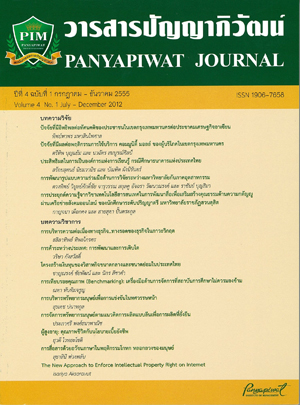การสื่อสารด้วยอวัจนภาษาในพฤติกรรมโกหก หลองลวง ของมนุษย์
Main Article Content
บทคัดย่อ
บทความนี้นำเสนอเกี่ยวกับการสื่อสารด้วยอวัจนภาษาที่ปรากฏในพฤติกรรมโกหก หลอกลวงของมนุษย์ ซึ่งมีการแสดงออกควบคู่ไปกับอารมณ์และความรู้สึกในลักษณะต่างๆ ทั้งที่เกิดขึ้นโดยรู้ตัวและไม่รู้ตัว รวมถึงพฤติกรรมนั้นเกิดขึ้นโดยตั้งใจและไม่ตั้งใจ การโกหกคือการจงใจกล่าวคำที่ไม่จริง พูดปด พูดเท็จ ส่วนการหลอกลวงคือการใช้อุบายทุจริตลวงให้บุคคลอื่นเข้าใจผิด มีนักวิจัยศึกษาพบว่า คนโกหก หลอกลวงจะมีการเตรียมพร้อมไว้ก่อนน้อยมาก อาจเล่าเรื่องที่ดูเหมือนจะเป็นไปได้ยาก ให้รายละเอียดน้อยลง อ้างถึงตัวเองน้อยลง พูดไม่คล่อง ลังเล พูดผิด ใช้ท่าทางประกอบการพูดน้อยลง เมื่อเล่าเรื่องใดก็ตามมักจะไม่ค่อยแก้ไขสิ่งที่พูด พูดจาในเชิงลบ อาจพูดก้าวร้าว ขี้บ่น ยิ้มน้อยลง มีการป้องกันตนเอง อาจใช้โทนเสียงสูง หรือดูกระวนกระวายได้ ลักษณะของพฤติกรรมเหล่านี้ มีทั้งภาวะที่ควบคุมได้ โดยแสดงออกให้เห็นทางใบหน้า ดวงตา ท่าทาง ระยะห่าง การแต่งกาย น้ำเสียง และภาวะที่ควบคุมไม่ได้ อันมีรูปแบบที่ผสมกลมกลืนไปกับอวัจนภาษาทั่วไปที่มนุษย์ใช้สื่อสารกันในปัจจุบัน อย่างไรก็ตาม ยังมีสาเหตุที่ทำให้การโกหก หลอกลวง ไม่ประสบผลสำเร็จ นั่นคือ เกิดจากขาดการเตรียมตัวที่ดี หรือมีอุปสรรคด้านอารมณ์ ทำให้เกิดพิรุธจนคู่สนทนาสามารถจับผิดได้ แม้ว่าพฤติกรรมโกหก หลอกลวงจะเกิดขึ้นกับมนุษย์อยู่เสมอ แต่สิ่งสำคัญคือ ควรใช้ความจริงใจกับคู่สนทนา เพื่อให้การสื่อสารดำเนินไปได้อย่างราบรื่น เกิดประโยชน์ต่อตนเองและสังคม
This paper presents the communication with nonverbal language in lying-deceit behaviors of human beings where expressions occur from emotions and feelings in different ways both consciously and unconsciously. Moreover, the behaviors appear both intentionally and unintentionally. LIE is the intention to present false information, while DECEPTION is the act of deceiving to make others misunderstand. Researchers found that liars are less forthcoming, they tell stories that seem implausible with fewer details, use fewer self-references, speak with stammering, uncertain, errors, fewer gestures. When liars tell stories, they rarely make corrections in their statements. They speak more negative statements, shout, complain, and smile less. They also defend themselves, and seem to use high pitch or fidgeting. These expressions have both the controllable condition which can be expressed on the face, by using eye movements, gestures, space, dresses, tones of voice; and the uncontrollable condition. These expressions are similar to general nonverbal communication of human beings in daily life. However, there are still the reasons for failure of lying-deceit behaviors which are the lack of well-preparedness or emotional trouble. These become cues and can be observed by the interlocutors. Even though lying-deceit behaviors always happen with human beings, the important thing is that we should be sincere with others we speak to in order to accomplish the communication, which is beneficial to us and society.
Article Details
“ข้าพเจ้าและผู้เขียนร่วม (ถ้ามี) ขอรับรองว่า บทความที่เสนอมานี้ยังไม่เคยได้รับการตีพิมพ์และไม่ได้อยู่ระหว่างกระบวนการพิจารณาลงตีพิมพ์ในวารสารหรือแหล่งเผยแพร่อื่นใด ข้าพเจ้าและผู้เขียนร่วมยอมรับหลักเกณฑ์การพิจารณาต้นฉบับ ทั้งยินยอมให้กองบรรณาธิการมีสิทธิ์พิจารณาและตรวจแก้ต้นฉบับได้ตามที่เห็นสมควร พร้อมนี้ขอมอบลิขสิทธิ์บทความที่ได้รับการตีพิมพ์ให้แก่สถาบันการจัดการปัญญาภิวัฒน์หากมีการฟ้องร้องเรื่องการละเมิดลิขสิทธิ์เกี่ยวกับภาพ กราฟ ข้อความส่วนใดส่วนหนึ่งและ/หรือข้อคิดเห็นที่ปรากฏในบทความข้าพเจ้าและผู้เขียนร่วมยินยอมรับผิดชอบแต่เพียงฝ่ายเดียว”
เอกสารอ้างอิง
กรรณิการ์ อัศวดรเดชา. (2553). การสื่อสารของมนุษย์ กรุงเทพฯ: บริษัท 21 เซ็นจูรี่ จํากัด.
กาญจนา โชคเหรียญสุขชัย. (2550). การสื่อสารเชิง อวัจนภาษา: รูปแบบและการใช้, กรุงเทพฯ : สํานักพิมพ์แห่งจุฬาลงกรณ์มหาวิทยาลัย.
พงษ์ วิเศษสังข์. (2552). ความรู้เบื้องต้นเกี่ยวกับการสื่อสาร (Introduction to Communication) พิมพ์ครั้งที่ 9. ปทุมธานี: มหาวิทยาลัยกรุงเทพ.
มลินี สมภพเจริญ. ทฤษฎีการสื่อสารระหว่างบุคคล(Theories of Interpersonal Communication). พิมพ์ครั้งที่ 2. กรุงเทพฯ: บริษัท Graphic Printing Prepress Systems (Thailand) Co., Ltd.
มหาวิทยาลัยมหาสารคาม, คณะมนุษยศาสตร์และ สังคมศาสตร์ ภาควิชาภาษาไทยและภาษาตะวันออก (2550). ศิลปะการแสดงออกทางภาษา พิมพ์ครั้งที่ 4 มหาสารคาม: สํานักพิมพ์มหาวิทยาลัยมหาสารคาม.
ราชบัณฑิตยสถาน. (2546) พจนานุกรมฉบับราชบัณฑิตยสถาน ฉบับ พ.ศ. 2542. กรุงเทพฯ: นานมีบุ๊คส์พับลิเคชั่นส์.
วิน เอี่ยมอ่อง. (2554). คุณโกหก. พิมพ์ครั้งที่ 3 กรุงเทพฯ: อมรินทร์ HOW-TO.
Daily Mail Reporter. (2011). Why You'll be Sorry if You Force a Smile While You're at Work. Retrieved July 20, 2012, from http:// www.dailymail.co.uk/sciencetech/article1360076/Youll-sorry-force-smile-youre work.html
Ekman, P. (1988). Lying and nonverbal behavior:Theoretical issues and new findings. Journal of Nonverbal Behavior. 12(3). 163-175.
Ekman, P. (1992). Telling Lies: Clues to Deceit in the Marketplace, Politics, and Marriage.New York: Norton.
Ekman, P. & Friesen, W. V. (1971). Constants cross culture in the face and emotion. Journal of Personality and Social Psychology, 17,124-129.
Jandt, F.E. (2010). An Introduction to Interculturural Communication: Identities in a Global Community. 6th ed. California: SAGE Publications.
Knapp, M.L. & Hall, J.A. (2006). Nonverbal Communication in Human Interaction. 6th ed. Ontario: Thomson Wadsworth.
Kranz, G. (2551). การสื่อสารอย่างมีประสิทธิภาพ:Communicating Effectively. แปลโดย บุญเลิศ วงศ์พรม. กรุงเทพฯ: บริษัทสํานักพิมพ์ยูเรก้า จํากัด.
Lowndes, L. (2554). ISNqiiungaulunnanjunysoi:How to Talk to Anyone. แปลโดย มินตา ภณปฤณ. กรุงเทพฯ: สํานักพิมพ์วีเลิร์น.
Matsumoto, D. & Ekman, P. (2008). Facial Expression Analysis. Retrieved April 1, 2012, from http://www.scholarpedia.org/article/Facial expression_analysis.
Matsumoto, D. & Hwang, H. S. (2011). Reading Facial Expressions of Emotion. Retrieved April 1, 2012, from http://www.apa.org/science/about/psa/2011/05/facial-expressions.aspx
Mazur, J.E. (2006). Learning and Behavior.6th ed. New Jersey: Pearson Prentice Hall.
Tubbs, S.L. & Moss, S. (2003). Human Communication - Principles and Contexts. 9th ed. New York: McGraw-Hill.


